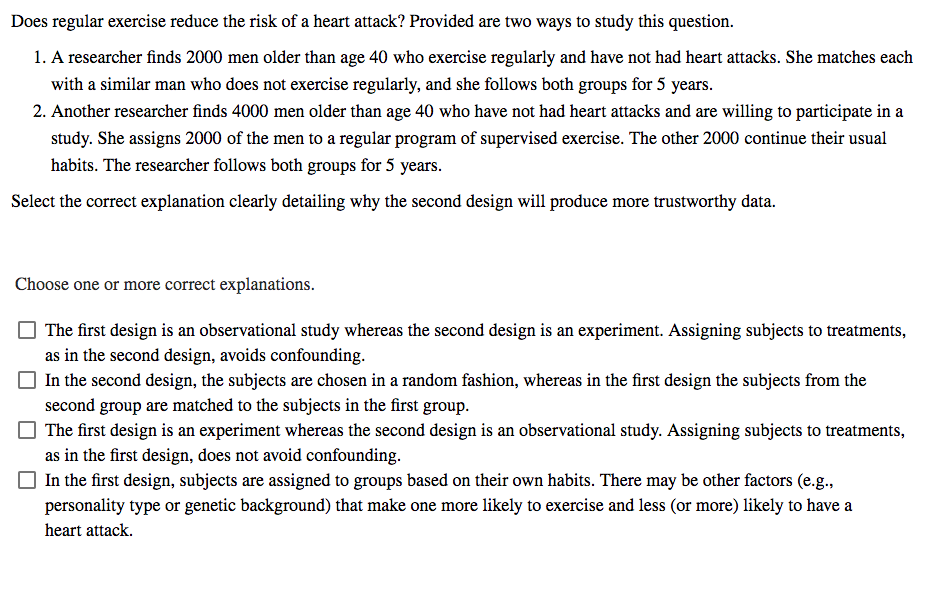Does regular exercise reduce the risk of a heart attack? Provided are two ways to study this question. 1. A researcher finds 2000 men older than age 40 who exercise regularly and have not had heart attacks. She matches each with a similar man who does not exercise regularly, and she follows both groups for 5 years. 2. Another researcher finds 4000 men older than age 40 who have not had heart attacks and are willing to participate in a study. She assigns 2000 of the men to a regular program of supervised exercise. The other 2000 continue their usual habits. The researcher follows both groups for 5 years. Select the correct explanation clearly detailing why the second design will produce more trustworthy data. Choose one or more correct explanations. The first design is an observational study whereas the second design is an experiment. Assigning subjects to treatments, as in the second design, avoids confounding. In the second design, the subjects are chosen in a random fashion, whereas in the first design the subjects from the second group are matched to the subjects in the first group. | The first design is an experiment whereas the second design is an observational study. Assigning subjects to treatments, as in the first design, does not avoid confounding. In the first design, subjects are assigned to groups based on their own habits. There may be other factors (e.g., personality type or genetic background) that make one more likely to exercise and less (or more) likely to have a heart attack.
Does regular exercise reduce the risk of a heart attack? Provided are two ways to study this question. 1. A researcher finds 2000 men older than age 40 who exercise regularly and have not had heart attacks. She matches each with a similar man who does not exercise regularly, and she follows both groups for 5 years. 2. Another researcher finds 4000 men older than age 40 who have not had heart attacks and are willing to participate in a study. She assigns 2000 of the men to a regular program of supervised exercise. The other 2000 continue their usual habits. The researcher follows both groups for 5 years. Select the correct explanation clearly detailing why the second design will produce more trustworthy data. Choose one or more correct explanations. The first design is an observational study whereas the second design is an experiment. Assigning subjects to treatments, as in the second design, avoids confounding. In the second design, the subjects are chosen in a random fashion, whereas in the first design the subjects from the second group are matched to the subjects in the first group. | The first design is an experiment whereas the second design is an observational study. Assigning subjects to treatments, as in the first design, does not avoid confounding. In the first design, subjects are assigned to groups based on their own habits. There may be other factors (e.g., personality type or genetic background) that make one more likely to exercise and less (or more) likely to have a heart attack.
Calculus For The Life Sciences
2nd Edition
ISBN:9780321964038
Author:GREENWELL, Raymond N., RITCHEY, Nathan P., Lial, Margaret L.
Publisher:GREENWELL, Raymond N., RITCHEY, Nathan P., Lial, Margaret L.
Chapter12: Probability
Section12.2: Introduction To Probability
Problem 52E
Related questions
Topic Video
Question

Transcribed Image Text:Does regular exercise reduce the risk of a heart attack? Provided are two ways to study this question.
1. A researcher finds 2000 men older than age 40 who exercise regularly and have not had heart attacks. She matches each
with a similar man who does not exercise regularly, and she follows both groups for 5 years.
2. Another researcher finds 4000 men older than age 40 who have not had heart attacks and are willing to participate in a
study. She assigns 2000 of the men to a regular program of supervised exercise. The other 2000 continue their usual
habits. The researcher follows both groups for 5 years.
Select the correct explanation clearly detailing why the second design will produce more trustworthy data.
Choose one or more correct explanations.
The first design is an observational study whereas the second design is an experiment. Assigning subjects to treatments,
as in the second design, avoids confounding.
In the second design, the subjects are chosen in a random fashion, whereas in the first design the subjects from the
second group are matched to the subjects in the first group.
| The first design is an experiment whereas the second design is an observational study. Assigning subjects to treatments,
as in the first design, does not avoid confounding.
In the first design, subjects are assigned to groups based on their own habits. There may be other factors (e.g.,
personality type or genetic background) that make one more likely to exercise and less (or more) likely to have a
heart attack.
Expert Solution
This question has been solved!
Explore an expertly crafted, step-by-step solution for a thorough understanding of key concepts.
This is a popular solution!
Trending now
This is a popular solution!
Step by step
Solved in 3 steps

Knowledge Booster
Learn more about
Need a deep-dive on the concept behind this application? Look no further. Learn more about this topic, statistics and related others by exploring similar questions and additional content below.Recommended textbooks for you

Calculus For The Life Sciences
Calculus
ISBN:
9780321964038
Author:
GREENWELL, Raymond N., RITCHEY, Nathan P., Lial, Margaret L.
Publisher:
Pearson Addison Wesley,

Glencoe Algebra 1, Student Edition, 9780079039897…
Algebra
ISBN:
9780079039897
Author:
Carter
Publisher:
McGraw Hill

Holt Mcdougal Larson Pre-algebra: Student Edition…
Algebra
ISBN:
9780547587776
Author:
HOLT MCDOUGAL
Publisher:
HOLT MCDOUGAL

Calculus For The Life Sciences
Calculus
ISBN:
9780321964038
Author:
GREENWELL, Raymond N., RITCHEY, Nathan P., Lial, Margaret L.
Publisher:
Pearson Addison Wesley,

Glencoe Algebra 1, Student Edition, 9780079039897…
Algebra
ISBN:
9780079039897
Author:
Carter
Publisher:
McGraw Hill

Holt Mcdougal Larson Pre-algebra: Student Edition…
Algebra
ISBN:
9780547587776
Author:
HOLT MCDOUGAL
Publisher:
HOLT MCDOUGAL